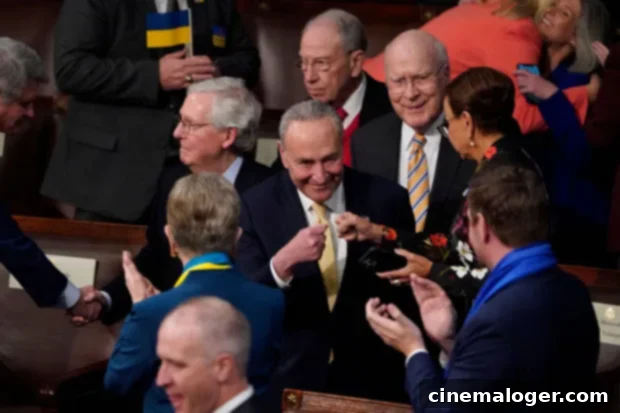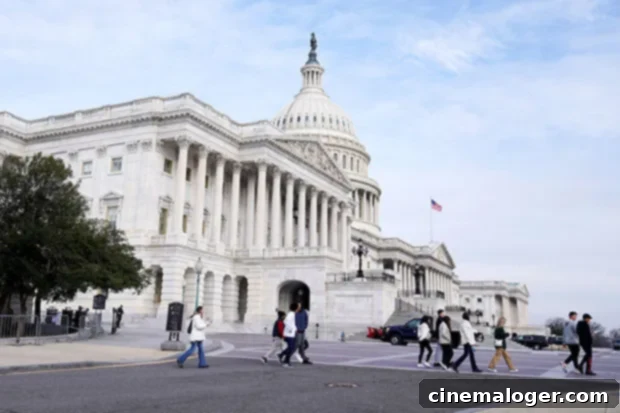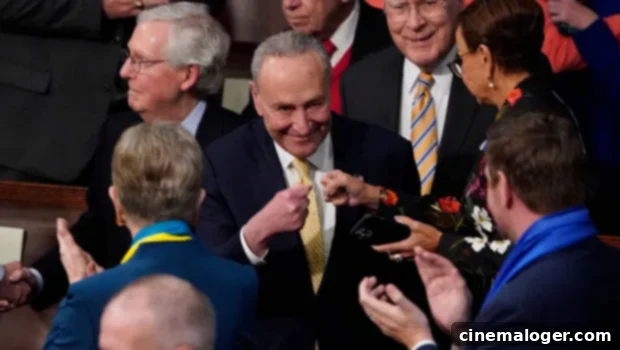Senator Chuck Schumer’s Viral SOTU Moment: Navigating Boos and Applause During Biden’s Address
The annual State of the Union address is a pivotal moment in American politics, a night where the President outlines the nation’s priorities and achievements before a joint session of Congress and the watchful eyes of the world. However, during President Joe Biden’s first official State of the Union on Tuesday, March 1, the evening took an unexpectedly viral turn thanks to an early, enthusiastic, and somewhat ill-timed standing ovation attempt by Senate Majority Leader Chuck Schumer.
New York Senator Chuck Schumer found himself at the center of a widely shared, pretty awkward moment. The Democratic politician was visibly excited, ready to leap to his feet and applaud President Joe Biden as the President began discussing the administration’s signature legislative achievement, the American Rescue Plan. What Schumer didn’t anticipate was that his eager gesture would be met not with fellow applause, but with a distinct chorus of boos from a section of the chamber, forcing him into a rather comical, swift retreat back into his seat.
Chuck Schumer getting up to a chorus of boo’s is the night’s first fantastic moment. pic.twitter.com/4SswT5sjBa
— ForAmerica (@ForAmerica) March 2, 2022
The American Rescue Plan: A Divisive Topic at the Heart of the Debate
The specific moment that sparked Schumer’s premature standing ovation and the subsequent boos was President Biden’s reference to the American Rescue Plan. This comprehensive COVID-19 relief package, enacted in March 2021, represented a cornerstone of Biden’s early legislative agenda. It was meticulously designed to provide substantial financial relief to American families, businesses, and state and local governments grappling with the profound economic fallout of the COVID-19 pandemic. Key provisions included direct stimulus checks to households, expanded unemployment benefits, critical aid for small businesses, and significant funding for vaccine distribution, testing, and public health initiatives. While widely lauded by Democrats and a significant number of economists for preventing a deeper recession and alleviating widespread hardship, the plan simultaneously drew sharp and immediate criticism from Republicans. Critics argued it was an overly expensive endeavor, contributed significantly to rising inflation, and contained provisions they deemed wasteful or unrelated to direct pandemic relief.
As President Biden highlighted the American Rescue Plan’s impact, he made a deliberate point to contrast his administration’s approach with that of his predecessor. He articulated, “Unlike the $2 trillion tax cut passed in the previous administration that benefitted the top one percent of Americans, the American Rescue Plan—.” It was at this precise juncture, drawing a direct and pointed comparison to former President Donald Trump’s 2017 tax cuts, that the boos erupted. This immediate negative reaction from a segment of the chamber underscored the deep partisan chasm surrounding economic policies and the lingering political tensions from the Trump era, even within the hallowed halls of Congress, where decorum is typically maintained.
However, the narrative of the moment quickly shifted. Despite the initial jeers, President Biden deftly steered the conversation, continuing to emphasize the tangible and positive benefits of the American Rescue Plan. He pointed to its success in helping working families across the country and ensuring that no one was left behind during an unprecedented national crisis. This strategic pivot in his rhetoric resonated with a different, and ultimately larger, segment of the audience, as Biden concluded his remarks on the plan with a triumphant declaration: “The American Rescue Plan helped working people and left no one behind.” This powerful statement was met with a resounding and roaring round of applause, demonstrating the complex and often instantaneous shifts in sentiment that characterize such highly charged political gatherings, where political allegiances and policy interpretations clash in real-time.
From Congressional Floor to Viral Sensation: Social Media Reacts
The fleeting yet memorable clip of Senator Schumer’s standing-then-sitting spectacle immediately went viral across social media platforms. In an age where political moments are dissected, shared, and memed in real-time, Schumer’s unscripted awkwardness became instant fodder for online humor and commentary. Viewers swiftly shared the video across Twitter, Facebook, and other platforms, finding the raw, human element of the gaffe undeniably funny and relatable. The sheer humor in wanting to show enthusiastic support but getting the timing spectacularly wrong struck a chord with a broad audience. The incident quickly spawned numerous reactions, with one viewer even creatively producing her own parody of the moment, reenacting Schumer’s hesitant rise and fall, further amplifying its reach and comedic impact throughout the online sphere.
This rapid proliferation of the clip highlighted how swiftly political blunders, no matter how minor, can be amplified and transformed into widely shared content online. It also served as a barometer of the public’s immediate engagement with live political events, often through a lens of humor, critical observation, and partisan identification. Despite the momentary gaffe, Senator Schumer quickly regained his composure and, following the conclusion of Biden’s address, demonstrated his unwavering support by sharing a celebratory GIF of himself joyously clapping and expressing his gratitude to the President. This quick recovery and public reaffirmation showcased a resilient political spirit and a clear commitment to the administration’s overarching message, even after an awkward start to the evening’s applause.
lol Chuck Schumer pic.twitter.com/NfwmofE36R
— Justin Baragona (@justinbaragona) March 2, 2022
chuck schumer at the state of the union pic.twitter.com/sJdZNfHEVm
— Alex Friedman (@kosherhotdogz) March 2, 2022
Soooo close, Chuck Schumer. #SOTU pic.twitter.com/499b7TwfAz
— The Recount (@therecount) March 2, 2022
Thank you, President Biden! 👏#SOTU pic.twitter.com/ZReIYv5FSy
— Chuck Schumer (@SenSchumer) March 2, 2022
Biden’s Eventful First Year: Defining Moments Ahead of the SOTU
President Biden’s first State of the Union address, his inaugural since officially taking office in January 2021, arrived on the heels of an exceptionally eventful and challenging first year. Having been elected in November 2020 amidst the throes of the global COVID-19 pandemic, Biden immediately inherited a nation deeply divided and facing a myriad of cascading crises. His administration was tasked not only with navigating a public health emergency and its severe economic repercussions but also with attempting to bridge profound political polarization that had intensified dramatically in recent years, making unity a constant, yet elusive, goal.
The Shadow of January 6th: Upholding Democratic Principles
One of the most significant challenges and defining moments of Biden’s first year was undoubtedly the lingering aftermath and profound implications of the January 6th Capitol Insurrection. Following his election, former President Donald Trump persistently propagated false accusations that the election had been stolen from him, a corrosive narrative often referred to as “The Big Lie.” This relentless dissemination of misinformation, fueled by political rhetoric and social media, culminated in the violent storming of the U.S. Capitol by his supporters on January 6, 2021. This unprecedented act of domestic terrorism was a desperate and ultimately failed attempt to overturn the election results and prevent the peaceful transfer of power, a cornerstone of American democracy.
President Biden has consistently and unequivocally spoken out against these rioters and against Trump’s actions, particularly delivering a poignant and powerful speech on the one-year anniversary of the riot. In that seminal address, Biden powerfully declared, “For the first time in our history, the president had not just lost an election, he tried to prevent the peaceful transfer of power as a violent mob stormed the capitol but they failed.” This steadfast defense of democratic institutions, the sanctity of elections, and the rule of law has been a central and recurring theme of his presidency, framing many of his calls for national unity and civility in a deeply fractured political landscape.

Global Crisis: Responding to the Invasion of Ukraine
Adding a critical and rapidly unfolding international dimension to his first year, the State of the Union address was delivered just days after a major geopolitical tremor: Russian President Vladimir Putin ordered a full-scale invasion of Ukraine. This unprovoked act of aggression sent profound shockwaves across the globe, immediately becoming a dominant topic on the international stage and domestically. Leading up to the SOTU, President Biden had already addressed the nation the week prior, unequivocally condemning Russia’s actions and outlining a robust response. During that initial speech, he announced a series of severe and coordinated sanctions against Russia, targeting its financial institutions, technological capabilities, and key oligarchs, while simultaneously pledging robust humanitarian and military aid to Ukraine.
His State of the Union address powerfully reiterated this firm stance, calling out Putin directly for the invasion and showcasing strong solidarity with the Ukrainian people who were bravely defending their homeland. Biden emphasized the resilient spirit of Ukraine, stating, “The Ukrainian people have known 30 years of independence, and they’ve repeatedly shown that they will not tolerate anyone who tries to take their country backwards.” The escalating crisis highlighted the immense responsibilities of global leadership, particularly during moments of international instability, and placed foreign policy at the forefront of the national discourse, profoundly influencing the tone and substance of Biden’s address to Congress and the American people.

A Historic Nomination: Shaping the Supreme Court
Amidst these difficult domestic challenges and escalating international crises, Biden’s first year also saw significant positive developments, including a truly historic nomination to the Supreme Court. The President announced his decision to nominate Judge Ketanji Brown Jackson to fill the seat soon to be vacated by Justice Stephen Breyer upon his retirement. This nomination was groundbreaking and culturally significant, as Jackson is the first Black woman ever chosen for the prestigious position on the nation’s highest court, fulfilling a key campaign promise.
Biden unveiled his choice on Friday, February 25, emphasizing her exceptional qualifications, extensive legal experience, and exemplary judicial temperament. In a tweet announcing his selection, he articulated his profound admiration for her qualities: “I have admired these traits: pragmatism, historical perspective, wisdom, and character in jurists nominated by Republican presidents as well as Democratic presidents. I am pleased to nominate Judge Ketanji Brown Jackson — a candidate who continues in this tradition.” Her nomination marked a significant step towards a more representative judiciary and represented a key fulfillment of one of Biden’s foundational campaign promises, injecting a note of optimistic progress and historical achievement into an otherwise tumultuous and challenging year for the administration.
The State of the Union: Reflecting a Nation in Flux
Ultimately, President Biden’s first State of the Union address served as a comprehensive report to the nation, meticulously encapsulating a year defined by unprecedented domestic and international challenges, alongside moments of significant achievement and forward-looking progress. From the internal strife highlighted by the January 6th insurrection and ongoing political polarization, to the global implications of the war in Ukraine, and the domestic policy debates surrounding the American Rescue Plan, the speech aimed to reassure, inform, and inspire a diverse and often divided populace. Senator Schumer’s brief moment of viral awkwardness, while undeniably memorable and a source of online amusement, became just one small anecdote in a night that sought to articulate and define the path forward for a nation navigating an exceptionally complex political, economic, and social landscape. The State of the Union remains a vital democratic tradition, offering a unique snapshot of the country’s condition and the administration’s vision for its future, providing both a retrospective and a roadmap for the coming year.
